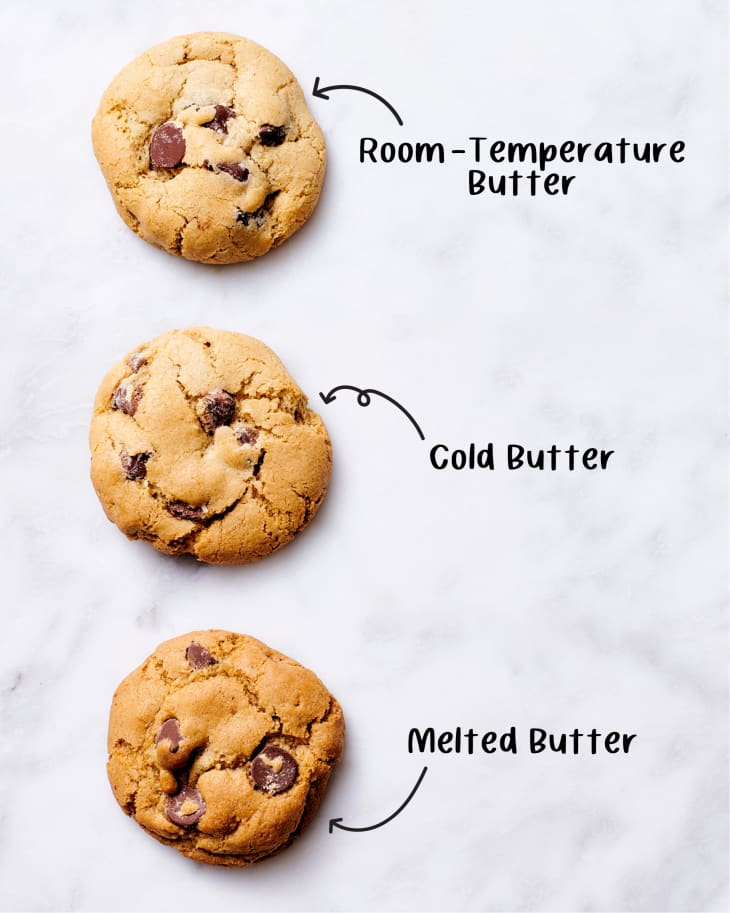Melted, Cold, Room-Temperature: Here’s How Butter Temperature Affects Cookies
In a never-ending quest to find the most perfect chocolate chip cookies of all time — seriously, we’ve ranked both high-effort and classic recipes — we learned that one of the most magical factors in cookie flavor and texture is also one of the most common baking ingredients: butter. While most recipes call for bringing butter to room temperature for creaming, some standout cookies call for melted or even cold butter to cut down on prep time or improve the texture of the finished cookies.
So let’s geek out for a bit on our favorite cookie ingredient and learn what melted, cold, and room-temperature butters do in our favorite cookie recipes.
What Does Butter Do in Cookies?
While butter is primarily fat that gives flavor, tenderness, and flaky layers to baked goods, it also has a bit of liquid (some water, some milk bits) that also contribute to structure and rise. For example, in a classic chocolate chip cookie, creaming together the butter and sugar incorporates air into the cookie dough. That air works with the baking soda or powder to puff or rise the cookie along with the steam created within the cookie thanks to the butter and egg’s moisture.
Butter also plays a critical role in cookie structure; the fat and moisture can enhance or inhibit gluten development, which directly impacts the shape, spread, and texture in your cookies. In short, the temperature of your butter for cookies directly impacts how cakey, crispy, or flaky your cookies will be.
What Does Softened Butter Do in Cookies?
Most cookie recipes call for beating room-temperature butter. At a temperature between 70 and 72 degrees F, butter is soft enough to incorporate air, but not so soft that it will melt immediately in the oven and result in super-thin cookies. This semi-soft form of butter also helps the fat coat proteins in the cookie dough, preventing gluten development — making a cookie that has a finer texture and is more cake-like than chewy.
What Does Melted Butter Do in Cookies?
Tara O’Brady’s Great Basic Chocolate Chip Cookie is a delicious example of a chewy cookie that is near perfect in texture, thanks to melted butter. O’Brady is specific that the butter be melted slowly, over low heat to prevent any evaporation. In its liquid state, butter mixes readily with both the sugar and flour, making for a softer dough that actually develops more gluten (thanks to the butter’s moisture hydrating the flour). If the just-mixed dough is baked straight away, cookies made with melted butter spread more than those made with room-temperature butter — good news for lovers of thin-and-crispy cookies. On the other hand, if you scoop cookie dough made with melted butter into rounds and then chill the dough before baking, you’ll end up with a cookie that is soft, chewy, and crispy only on the edges.
What Does Cold Butter Do in Cookies?
There is a case to be made for making some cookies with cold butter. When incorporated in its harder, from-the-fridge state, butter makes baked goods flaky by creating layers in the dough and cutting through gluten development. Pie crust and croissants are prime examples of butter’s cold, hard form being used to make a better texture. Sarah Copeland’s Thousand Layer Cookies are a good example of manipulating butter while cold: The dough is made with room-temperature butter but then chilled to harden the butter, then the dough is rolled and folded to create a flaky layered chocolate chip cookie. This cold butter technique makes for a super-crispy cookie with a tender center.
Now that you know how butter impacts your cookie recipes, you can go forth and make your favorite chocolate chip cookies just the way you like them!
